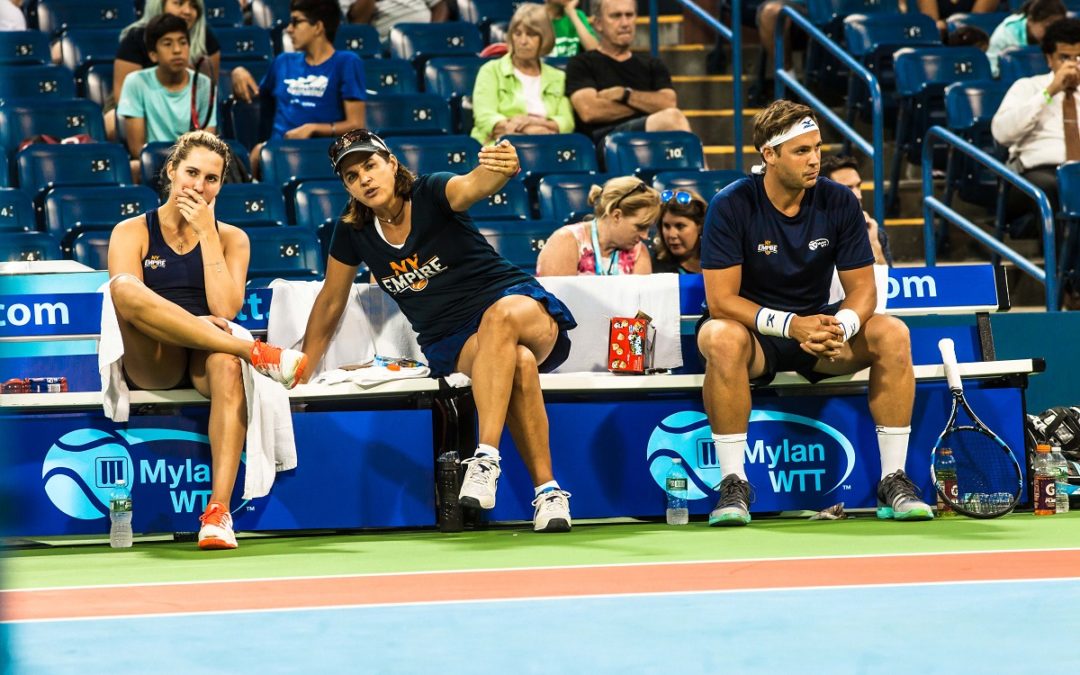Gigi Fernandez is the world’s leading expert when it comes to playing and coaching doubles. Herself a 17 time Grand Slam champion, turned Grand Slam winning coach working with Samantha Stosur and Lisa Raymond and now widely known for delivering her proven method to club and competitive players.
Believe us when we say that give the chance to work face to face with Gigi, you should take it!
Click here to spend 3 hours with Gigi Fernandez live in New York City
Tips from Gigi:
When you are paired with a new partner, how do you decide who plays what side…deuce or ad?
USTA recreational players should be able to play both sides. Sometimes players are thrown into a team situation and don’t have a clue who their partner is or they know their partner but have never played together. This is not a good recipe for great partnerships, but it’s common in USTA play.
Often players have a preference for a side and if you are lucky, you and your new partner have a preference for a different side. If that is the case… great… if not…then what do you do?
There are three important questions that you should discuss with your new partner before you go on the court. The answers to these questions will help you decide who should play what side to be more effective on the court.
1. Level Analysis
Who is the best player on the team? If there is a clear better player, that player should play the ad side. They should be better equipped to handle the higher pressure and all-important break points.
2. Groundstroke Analysis
Which groundstroke is better for each player and does anyone have a weak groundstroke. Ideally, you want your stronger groundstroke as an outside shot. (for righties – forehand on the deuce side, backhand on the ad side). If you have a clear groundstroke weakness you want that shot in the middle of the court, where it is less accessible by your opponent.
3. Volley Analysis
At the recreational level, most players have a better forehand (FH) volley and are better able to poach with a FH volley. They usually prefer the stronger FH volley on the ad side so they can poach with a FH volley. However, it is important to consider the Backhand (BH) volleys as well. Who has the better BH volley? Whoever has the stronger BH volley should be on the deuce side. This way the stronger BH is in the middle and the weaker BH volley is on the ad where not many outside volleys are hit from the alley. Because, in doubles, most shots go through the middle, you are better off with strong volleys in the middle at the net.
The Volley Analysis overrides the Groundstroke Analysis if there is a discrepancy in the strengths. Let’s say, for example, Mary has a stronger FH groundstroke than a BH groundstroke. In the groundstroke analysis, Mary would be playing the deuce side. However, Mary likes to come to the net. Mary’s FH volley is much stronger than her BH volley. Mary should then play the ad side. The reason for this is that because whether you are serving or returning, with Mary at the back and her partner at the net, it is hard to hit a ball from the opposite side that hits the middle of the court where the net person won’t poach and put it away. Many players like to return wide when the opponent has a player at the net. In the situation, when both players are at the baseline, the person with the stronger middle shot should control the middle.
Answering these questions should help you and your new partner decide who should play what side. If it doesn’t work on the first set you can always switch sides for the second set.
Sign up now to spend 3 hours with Gigi Fernandez live in New York City

original article posted on www.gigifernandez.com


Good tips/questions. Also, you can put your stronger side (fh or bh volley) at the net by playing Aussie and poach on your stronger side (and make them return to the server’s stronger side more often by playing Aussie). If they aren’t used to playing Aussie – practice it – it works and after getting used to it – It’s fun and drives other players crazy who aren’t used to it. Also, practice fakes (after poaching for a winner), signals – try different things. More things you can do that your opponent can’t do, the more of an advantage you have over your opponent.
Great insight Jon. It’s always imperative to mix it up in doubles!